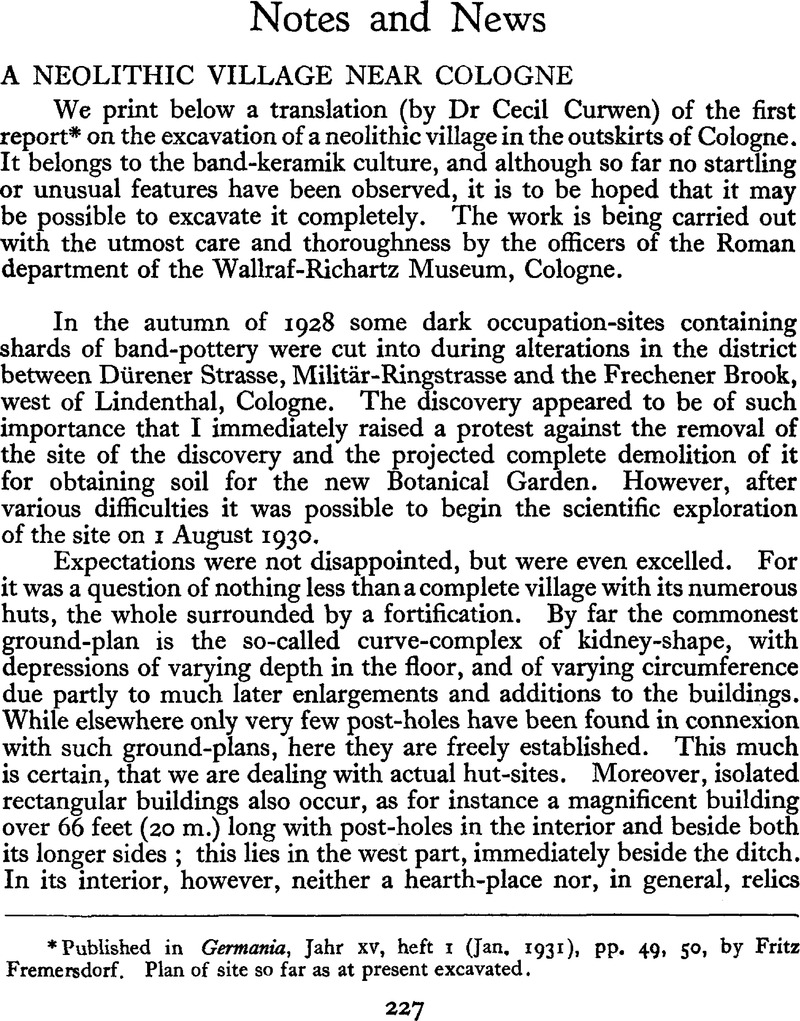No CrossRef data available.
Article contents
Notes and News
Published online by Cambridge University Press: 02 January 2015
Abstract

- Type
- Notes and News
- Information
- Copyright
- Copyright © Antiquity Publications Ltd 1931
References
* Published in Germania, Jahr XV, heft I (Jan. 1931), pp. 49, 50, by Fritz Fremersdorf. Plan of site so far as at present excavated.
* From ‘ The workes of Sir Thomas Moore‘, 1557 [Bodl. reference, Douce M.M. 398] : book IV, chapter 14, p. 277.Google Scholar
* In the German publication referred to below mention is made of the discovery of Niedermendig lava in a Pict’s mound (Pictenwall) in Scotland, and Dr Brink in the Mayener Geschichtsbuch, is quoted as the authority for the statement. On enquiry at the National Museum of Scotland, Mr J. Graham Callander tells me that nothing is known there of this alleged discovery.
* A note on deciphering palimpsests by MrDodds, L.V. is printed in ANTIQUITY, 1929, 3, 219–21.Google Scholar
* An article on Arthur’s battles by MrCollingwood, W.G. is printed in ANTIQUITY, 1929, 3, 292–8.Google Scholar
1 ‘Et a regno Guorthigimi usque ad discordiam Guitolini et Ambrosii anni sunt duodecim, quod est Guollopum, id est Catguoloph. Chronica Minora, ed. Mommsen,, Th., vol. 3, (Berlin, 1898), p. 209.Google Scholar
2 An attempt to reduce these facts to order proved unsuccessful, for they are mutually irreconcilable.
3 The ‘Irish Nennius’ (Todd’s edition, 1848p.99) says that Vortimer ‘rose up against Hengist and Horsa’ after Vortigern had retired (probably under pressure) to the west. Then follows an account of his four battles with them, culminating in a victory on the coast. We obtain the date of one of these battles, A.D. 455, from the O.E. Chronicle. The names differ in the two accounts, but the battles can be identified by the fact that in each is the statement that Horsa was killed at one of the battles. The Chronicle states that ‘Wurtgern’ was the British leader, but this may well be an error for Vortimer his son who is not mentioned in the Chronicle. I prefer to follow the comparatively full and here quite consistent stay of events given by ‘Nennius’; but in any case, since this is the last mention of Vortigern in the Chronicle, the argument is not affected.
4 cf. Stevenson, W.H. in English Historical Review, 17, 631.Google Scholar
5 Can this be the ‘fontem Galabes, in natio ne Gewisseorum’ where according to Geoffrey of Monmouth, the messengers of Ambrosius found Merlin, before the building of Stonehenge? (ed. Giles, , 1844, p. 140 : book VIII, ch. 10).Google Scholar
6 There were two battles of Mons Badonicus. The first, which is the one here in question, is mentioned by Gildas, Bede, Nennius and the ‘Annales Cambriae’; the second between Cenwalch and the Britons, by the ‘Annales Cambriae’ only (under the year 667, corrected date).
7 Quoted in Oman, England before the Norman Conquest, 1910, 201 (valuable notes summarizing current views on the problem).Google Scholar
8 Todd, , p. 99.Google Scholar


